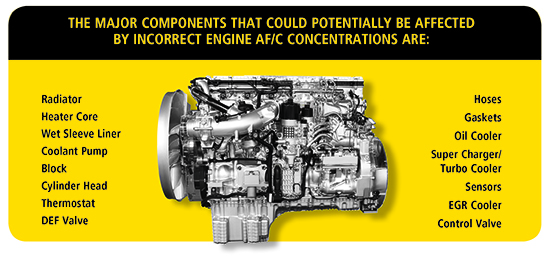Coolant Complications & Confusion

Nitrite Challenges Dictate an Important Dialogue
Until Prestone introduced the first all-season, the first modern cooling system fluid back in 1927, common kitchen ingredients such as sugar, honey and molasses were used. Since 1927, ethylene glycol, with integral corrosion inhibitors, remains the major component of antifreeze/coolant (AF/C) to this day.
When maintained and working properly, AF/C provides four key functions:
- Controls critical engine temperature by providing efficient heat transfer
- Prevents boilover and overheating failures
- Prevents freeze-ups or non-starts in the colder temperatures
- Prevents corrosion that can cause engine failure
If AF/C is unable to satisfy these requirements, the vehicle’s emissions, fuel economy, horsepower, and engine component durability will be compromised.
Implications of Higher Fuel Economy
In response to the rising cost of fuel and growing environmental concerns, the industry saw increased pressure to improve emissions and obtain a higher fuel economy. To achieve these results, significant design changes were needed.
Lighter materials were used to build engines and cooling systems, including a move from copper/brass to aluminum radiators. Early aluminum radiators were manufactured by assembly lines or through a vacuum brazing process. Later, to improve production efficiency, a new process called controlled atmosphere brazing (CAB), was developed.
While CAB improved efficiency, the process leaves behind varied levels of residual brazing flux, which can react with certain coolant inhibitors. As a result, fleets began to experience a quick decrease of nitrite concentrate with a corresponding pH spike in their coolants. This chemistry resulted in an increased corrosion rate on aluminum cool system components. This corrosion created damaging particulates which clogged filters, created pitting, and led to a dramatic increase in engine failures.
While vehicles with copper/brass radiators didn’t have this issue, vehicles with CAB brazed aluminum radiators were left vulnerable.
A Shift in Nitrite Technology Created Confusion
Heeding concerns that NOAT (a nitrite-containing Organic Acid Technology) wasn’t providing the same level of protection for aluminum systems, a number of OEMs changed their factory fill coolant from NOAT to nitrite-free extended life coolant (NF OAT). While these changes from NOAT to NF OAT eliminate issues caused by nitrites, it opened the door for another issue: confusion around the AF/C’s color.

Coolants Go Colorblind
Even after moving from NOAT to NF OAT, some heavy duty OEMs have kept coolants the same color. Unaware of the change, fleets have been incorrectly mixing coolant technologies potentially putting their fleets at risk against corrosion and cooling system failures.
While some manufacturers differentiate coolant color with cooling system stickers, color alone is no longer the definitive measure by which to identify a fluid type.
Coolant Solutions for your Fleet
With all of these Nitrite-related issues, the good news is there’s a dialogue taking placewithin the industry. The goal is to develop a standardized color code for all coolant technologies to make it easier for the fleets to identify their coolant types. In the meantime, here are some solutions to make sure your fleet is covered.
Work with a Knowledgeable Technician
If an AF/C type isn’t known, the fluid should be tested immediately to determine its exact technology and the correct coolant technology to use. Make sure your technicians test for, identify, and correct any issues with your cooling system fluids. Having a conversation with your certified technician, and making sure you have the most current technology can save you uptime and repair costs.
Use a Trusted Formula
To avoid any confusion for fleet owners, Prestone clearly differentiates its three AF/C technologies: IAT (purple), NOAT (red) and NF OAT (yellow). And for clarity, Prestone has implemented the same color codes for accompanying SCAs, extenders and test strips. Prestone offers test kit mailers that provide fleet owners a quick way to determine the best approach for cooling system maintenance.
When in doubt, flush it out!
It’s imperative that drivers and fleet owners know exactly what type of AF/C is helping run their engines. If all else fails, flush out your system and start fresh with a clearly labeled formula.
Questions on coolant? Please contact us for help!
Have your say
This is a moderated forum. Comments will no longer be published unless they are accompanied by a first and last name and a verifiable email address. (Today's Trucking will not publish or share the email address.) Profane language and content deemed to be libelous, racist, or threatening in nature will not be published under any circumstances.